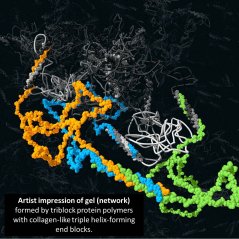
Project
BioMate - modular protein polymers and their nanoassemblies
The natural protein synthesis ‘machinery’ in micro-organisms can be used to create novel protein-like polymers that consist of a string of polymer segments (also called ‘modules’ or blocks) with structures inspired by collagen, silk, elastin and other natural fibrous proteins.
The resulting natural polymer molecules can interact with neighbouring molecules and spontaneously give rise to supra-molecular structures such as nano-fibres, nano-coatings, networks/gels, etc. Because, like proteins, they are made entirely of natural amino acids, and can be fully degraded when needed, they are typically well-tolerated in the body. Yet, their design is determined in the laboratory, and different designs result in specific, but very different behaviour. For example, gel formation, fibre formation, or phase separation can be reversibly steered by changes of temperature, salinity, or acidity (pH), and degradation can be triggered by similar stimuli. In addition, bio-active groups can be built in.

The development of protein polymers is driven by the desire to create specific material properties and functionalities in a rational way, for medical/pharmaceutical and other high-tech applications. The study of the polymers, created by rational design and combination of new and existing ‘modules’, not only generates possibilities for novel practical application, but also provides insight into the relevant structure-function relationships.
Polymers were composed of novel combinations of existing as well as novel modules and typically produced at high yield in yeast cells. Novel modules are selected and designed in order to give rise to novel supramolecular polymer assemblies, taking into account the expected suitability for high yield production as secreted proteins. The products are studied using various physical techniques such as rheology, visible light- and X-ray scattering, atomic force microscopy, various forms of spectroscopy, etc.. The potential suitability of some polymers for regenerative medicine is also studied in in-vitro cultures.
A detailed insight in structure-function relationships and stimulus- (pH- temperature-) responsivity is generated. The influence of solid surfaces (boundaries) present in the system is taken into account, as well as the structure and electrostatic charge of those surfaces.
Project financing
ERC Advanced Grant from European Research Council (prof. dr. M. A. Cohen Stuart)